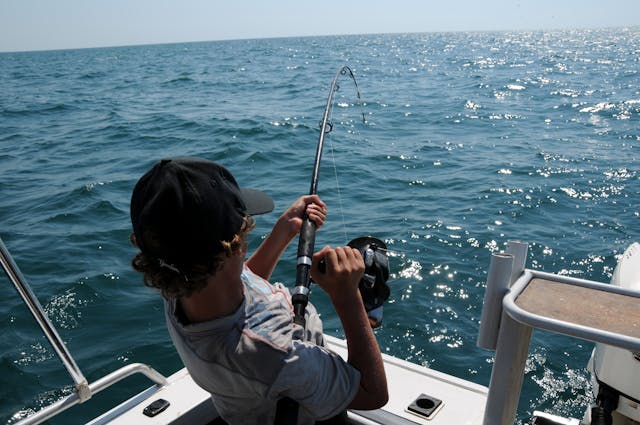Saltwater fishing holds a special allure for anglers worldwide, offering the thrill of battling powerful fish amidst the vast expanse of the ocean. Whether you’re standing on the shore, feeling the spray of the waves as you cast your line, or venturing offshore in pursuit of trophy catches, the right fishing rod is indispensable. It serves as your trusted companion, translating your skill and technique into successful hookups and memorable moments on the water. In this comprehensive guide, we’ll delve into the world of saltwater fishing rods, exploring a curated selection of top-tier options meticulously crafted to cater to diverse fishing styles and preferences.
From the rugged coastline to the deep blue sea, each fishing environment presents its own set of challenges and opportunities. With an array of factors to consider, including rod material, length, action, and power, finding the perfect rod can seem daunting. However, armed with knowledge and insight, you can navigate the vast sea of options with confidence. Join us as we embark on a journey through the best saltwater fishing rods, handpicked to elevate your angling experience and ensure countless hours of excitement and success on the water.
Factors to Consider When Choosing a Saltwater Fishing Rod
Before delving into specific rod recommendations, it’s essential to understand the key factors to consider when selecting a saltwater fishing rod:
- Material: Saltwater fishing rods are typically made from graphite, fiberglass, or a combination of both. Each material offers unique advantages in terms of strength, sensitivity, and durability.
- Length: The length of the rod affects casting distance, leverage, and maneuverability. Longer rods are ideal for surf fishing, while shorter rods are better suited for inshore or offshore fishing.
- Action: Rod action refers to how much the rod bends when pressure is applied. Fast-action rods bend primarily in the top third, offering greater sensitivity and control, whereas slow-action rods bend throughout their length, providing more power.
- Power: Power, or rod strength, determines the amount of force needed to bend the rod. Light rods are suitable for smaller fish and lighter lures, while heavy rods are designed for larger fish and heavier baits.
Features to Consider for Saltwater Fishing Rods for Different Fishing Styles
Surf Fishing
When it comes to surf fishing, selecting the right fishing rod is paramount to success. The unique challenges posed by surf fishing demand a rod specifically designed to handle the dynamic environment of the shoreline. One crucial feature to consider is the rod’s length, as longer rods ranging from 9 to 12 feet are preferred for surf fishing. This extended length allows anglers to cast their bait or lure beyond the breaking waves, reaching deeper waters where fish often congregate. Additionally, a longer rod provides greater leverage when fighting fish, helping anglers maneuver and control their catch in the surf.
Another essential consideration for surf fishing rods is their action and power. A rod with a moderate to fast action is ideal, as it allows for long, accurate casts while still providing the sensitivity needed to detect subtle bites. Additionally, surf fishing rods should possess sufficient power to handle the strong currents and large fish commonly encountered in surf environments. A medium to heavy power rating is typically preferred, giving anglers the strength and backbone to tackle a variety of saltwater species. Furthermore, durability is key when choosing a surf fishing rod, as it will be subjected to the abrasive effects of sand, saltwater, and rough surf conditions.
Deep Sea Fishing
When venturing into the depths for deep-sea fishing, anglers require specialized fishing rods capable of handling the demanding conditions and formidable opponents found in offshore waters. One crucial aspect to consider when selecting a deep-sea fishing rod is its construction material. Opting for a rod crafted from durable materials such as carbon fiber or fiberglass ensures it can withstand the immense pressure and punishing forces encountered in deep-sea environments. Additionally, the rod’s build quality should include reinforced guides and a sturdy reel seat to prevent damage from heavy tackles and aggressive gamefish.
Another vital feature of a deep-sea fishing rod is its power and action. Given the potential size and strength of deep-sea species like marlin, tuna, and swordfish, anglers require rods with substantial power to control and land these trophy catches. Rods with a heavy power rating provide the necessary backbone to handle large fish and heavy-duty tackle, while a fast or extra-fast action ensures quick hook sets and effective fish-fighting capabilities. Furthermore, versatility is key when selecting a deep-sea fishing rod, as anglers may encounter a variety of fishing techniques and conditions offshore. Look for rods with a balanced blend of power and sensitivity, allowing for effective trolling, jigging, and bottom fishing applications. By prioritizing these essential features, anglers can choose a deep-sea fishing rod that delivers the performance and reliability needed to conquer the challenges of offshore angling.
Inshore Fishing
When it comes to inshore fishing, selecting the right fishing rod is crucial for maximizing success in shallow coastal waters. One key consideration for inshore fishing rods is their sensitivity. Inshore species such as redfish, snook, and speckled trout often inhabit areas with varying bottom structures and vegetation, requiring anglers to feel even the slightest bites. Therefore, choosing a rod with high sensitivity allows anglers to detect subtle movements and strikes, increasing their chances of hooking into elusive inshore gamefish.
Another important feature to consider when selecting an inshore fishing rod is its versatility. Inshore fishing environments can vary widely, from shallow flats and mangrove-lined shorelines to deep channels and oyster bars. As such, anglers require a rod that can adapt to a range of fishing techniques and conditions. Opting for a rod with a medium power rating and a fast action allows for versatility in lure presentation, whether casting lightweight artificial baits or live bait rigs. Additionally, a shorter rod length of around 6 to 7 feet provides the maneuverability needed for precise casts and accurate lure placement in tight quarters. By prioritizing sensitivity and versatility, anglers can select an inshore fishing rod that offers the responsiveness and adaptability required to excel in the diverse and dynamic world of inshore angling.
Offshore Fishing
Offshore fishing demands specialized equipment tailored to withstand the challenges of deep-sea environments and the powerful adversaries lurking beneath the surface. When selecting a fishing rod for offshore excursions, durability takes precedence. Offshore conditions can be harsh, with saltwater, rough seas, and large gamefish putting rods to the test. Therefore, choosing a rod constructed from high-quality materials such as graphite or composite blends ensures resilience against corrosion and structural integrity in the face of relentless offshore conditions. Reinforced guides and a sturdy reel seat further enhance durability, providing anglers with confidence in their equipment when battling trophy catches in the open ocean.
In addition to durability, offshore fishing rods must possess the power and performance necessary to handle the formidable species inhabiting deep waters. Opting for a rod with a heavy power rating is essential for taming large pelagic species such as marlin, tuna, and sailfish. These rods offer the backbone and strength required to control powerful runs and bring hefty fish to the boat. Furthermore, a fast or extra-fast action ensures quick responsiveness and efficient hook sets, crucial for capitalizing on fleeting opportunities in the fast-paced offshore environment. Versatility is also key when selecting an offshore fishing rod, as anglers may employ various techniques such as trolling, jigging, and bottom fishing during offshore expeditions. By prioritizing durability, power, and versatility, anglers can choose an offshore fishing rod capable of withstanding the rigors of deep-sea angling while delivering the performance needed to tackle the ocean’s most formidable inhabitants.
Conclusion
The world of saltwater fishing rods is as vast and dynamic as the oceans themselves, offering a multitude of options to suit every angler’s needs and preferences. Whether you’re a seasoned veteran or just dipping your toes into the world of saltwater angling, investing in the right rod can significantly enhance your fishing adventures. By considering factors such as material, length, action, and power, you can pinpoint the perfect rod to match your fishing style and target species. With advancements in rod technology and design, today’s anglers have access to a diverse range of rods engineered for optimal performance and durability in the harsh saltwater environment.
Selecting the right saltwater fishing rod is not merely about choosing a piece of equipment—it’s about unlocking a world of possibilities and embarking on unforgettable fishing journeys. Each rod represents a gateway to new experiences, whether it’s battling trophy fish from the surf, exploring remote offshore reefs, or stalking elusive inshore species in shallow waters. As you cast your line into the boundless expanse of the ocean, your fishing rod becomes more than just a tool—it becomes a conduit for adventure, discovery, and connection with the natural world. So, whether you’re chasing trophy marlin in the deep blue or casting for redfish along the mangrove-lined shores, may your rod be your faithful companion, guiding you towards moments of triumph, serenity, and pure angling bliss.
Frequently Asked Questions (FAQs)
Q1: What is the best material for saltwater fishing rods?
A1: Graphite and fiberglass are both popular materials for saltwater fishing rods, offering a balance of strength, sensitivity, and durability.
Q2: What length of rod is ideal for surf fishing?
A2: Surf fishing rods typically range from 9 to 12 feet in length, providing the necessary leverage for casting beyond the breaking waves.
Q3: Can I use a freshwater fishing rod for saltwater fishing?
A3: While some freshwater rods may be suitable for light saltwater applications, it’s generally recommended to use rods specifically designed for saltwater conditions to prevent corrosion and damage.
Q4: What is rod action, and why is it important?
A4: Rod action refers to how much the rod bends when pressure is applied. It influences casting distance, hook-setting ability, and fish-fighting performance, making it a crucial consideration when choosing a fishing rod.
Q5: Are longer rods always better for saltwater fishing?
A5: Longer rods offer advantages in terms of casting distance and leverage, making them well-suited for surf fishing. However, shorter rods may be preferable for certain fishing styles, such as inshore or offshore fishing, where maneuverability is key.
Q6: What type of reel should I pair with a saltwater fishing rod?
A6: It’s essential to match your rod with a high-quality saltwater reel capable of handling the specific demands of saltwater fishing. Look for reels with corrosion-resistant materials, smooth drag systems, and ample line capacity.
Q7: How often should I clean and maintain my saltwater fishing rod?
A7: Regular cleaning and maintenance are crucial for prolonging the lifespan of your saltwater fishing rod. After each use, rinse the rod with freshwater to remove salt residue, and periodically inspect the guides and reel seat for signs of corrosion or damage.
Q8: Can I use braided line with a saltwater fishing rod?
A8: Yes, many saltwater anglers prefer braided fishing line for its strength, sensitivity, and thin diameter. However, it’s essential to choose a rod with guides designed to accommodate braided line to prevent line wear and friction.
Q9: What is the difference between spinning and casting rods for saltwater fishing?
A9: Spinning rods feature a fixed spool reel mounted beneath the rod, while casting rods are designed for use with baitcasting reels, which sit atop the rod. Each type has its advantages and is suited to different fishing techniques and personal preferences.
Q10: Are telescopic saltwater fishing rods a good choice for travel?
A10: Telescopic fishing rods offer convenient portability and are popular among traveling anglers. However, they may sacrifice some performance compared to traditional one-piece or multi-piece rods. It’s essential to choose a high-quality telescopic rod to ensure durability and reliable performance on your fishing adventures.







